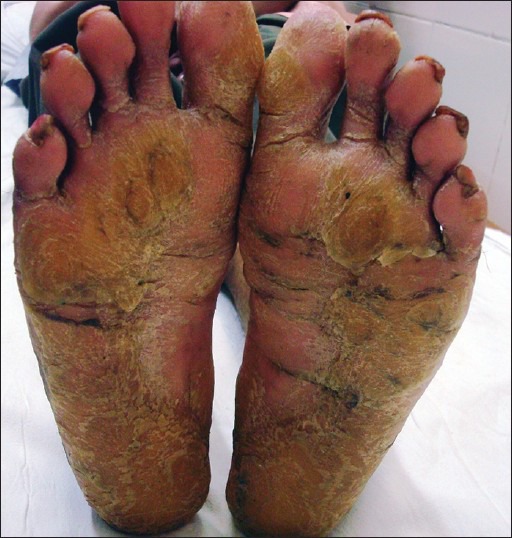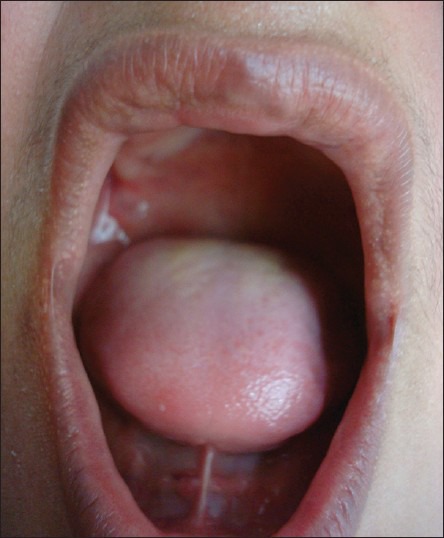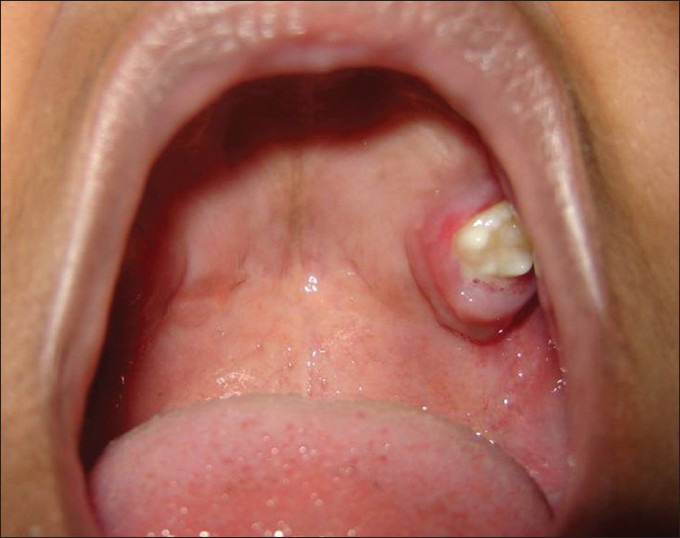Sir,
Two sisters, aged 16 and 13 years, born out of second degree consanguineous marriage, presented with hyperkeratosis of palms and soles. Both the siblings gave history of onset of palmo-plantar keratoderma with erythema, at the age of seven months and loss of teeth at an early age. They had history of recurrent skin infections. Dermatological examination revealed palmo-plantar hyperkeratosis with scaly plaques over Knee and elbow [Figure 1]. Oral examination revealed loss of most of the permanent teeth [Figures 2 and 3]. Based on these findings, They were diagnosed as Papillon-Lefevre Syndrome. Within few months of diagnosis, the younger sister developed fever with chill, lasting more than two weeks, for which she was admitted in the paediatric ward. As liver abscess is a known complication of Papillon-Lefevre Syndrome, Ultra Sound of abdomen was done, which showed mild hepatomegaly with organized abscess in right lobe of the liver, which was drained under anaesthetist supervision. She was put on Cap cloxacillin and injection gentamycin for four weeks. Repeat ultra sound showed complete resolution of the abscess.
Figure 1.

Plantar keratoderma
Figure 2.

Oral cavity showing absence of teeth
Figure 3.

Oral cavity of second patient showing loss of most of the teeth
Papillon-Lefevre syndrome is rare genodermatoses characterized by palmo-plantar hyperkeratosis and hyperhidrosis with severe periodontal destruction involving both the primary and permanent dentition.[1] It is transmitted as an autosomal-recessive inheritance. Consanguinity of parents is evident in about one third of cases.[1] It was first described by two French physicians, Papillon and Lefevre, in 1924.[2] It has a prevalence of 1-4 cases per million persons.[3] It equally affects both male and female with no racial predominance.[2]
Genetic studies have shown that mutations in the major gene locus of chromosome 11q14 with loss of function of cathepsin c gene are responsible for Papillon-Lefevre Syndrome.[3] The etiology of this syndrome is found to be related to generalized epithelial dysplasia or to be an endocrinopathy, suggesting the possibility of Vit. A deficiency.[1]
Patients are normal at birth.[3] Palmoplantar keratoderma usually starts within the first four years of life with sharply demarcated erythematous keratotic plaques involving palms and soles, sometimes extending on to the dorsal surfaces of the hands and feet.[4] The other characteristic feature of PLS is progressive early onset periodontitis which starts by the age of 3 or 4 years, affecting both deciduous as well as permanent teeth.[4] Teeth are lost in eventually in the same sequence in which they are erupted.[3] Majority of the teeth are lost by the age of 14-15 years.[1] The teeth erupt normally but are soon lost.[4,5] In addition to palmoplantar keratosis and periodontitis, other clinical findings in this condition include recurrent pyogenic skin infections, acro-osteolysis, atrophic changes of the nails, arachnodactly, and a peculiar radiographic deformity of the finger consisting of tapered, pointed phalangeal ends, claw like volar curve, and pes planus.[2]
Increased susceptibility to infections has been reported in about 20% of patients with Papillon-Lefever syndrome, possibly due to some dysfunction of leukocytes.[4] Patients with PLS are predisposed to develop pyogenic liver abscess.[4] Bacteremia occurs in normal and immunocompromised hosts; however, it is usually transient and rarely seeds the liver in immunocompetent individuals.[6]
References
- 1.Muppa R, Prameela B, Duddu M, Dandempally A. Papillon-lefevre syndrome: A combined approach from the dermatologist and dentist – A clinical presentation. Indian J Dermatol. 2011;56:740–3. doi: 10.4103/0019-5154.91843. [DOI] [PMC free article] [PubMed] [Google Scholar]
- 2.Subramaniam P, Mathew S, Gupta KK. Papillon-Lefevre syndrome: A case report. J Indian Soc Pedod Prev Dent. 2008;26:171–4. doi: 10.4103/0970-4388.44037. [DOI] [PubMed] [Google Scholar]
- 3.Rathod VJ, Joshi NV. Papillon-Lefevre syndrome: A report of two cases. J Indian Soc Periodontol. 2010;14:275–8. doi: 10.4103/0972-124X.76934. [DOI] [PMC free article] [PubMed] [Google Scholar]
- 4.Dhanawade SS, Shah SD, Kakade GM. Papillon-lefevre syndrome with liver abscess. Indian Pediatr. 2009;46:723–5. [PubMed] [Google Scholar]
- 5.Siragusa M, Romano C, Batticane N, Batolo D, Schepis C. A new family with Papillon-Lefevre: Effectiveness of etretinate treatment. Cutis. 2000;65:151–5. [PubMed] [Google Scholar]
- 6.Almuneef M, Al-Khenaizan S, Al-Ajaji S, Al-Anazi A. Pyogenic liver abscess and Papillon-Lefevre syndrome: Not a rare association. Pediatrics. 2003;111:85–8. doi: 10.1542/peds.111.1.e85. [DOI] [PubMed] [Google Scholar]


